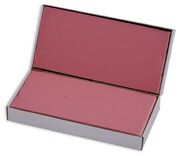
Foot impression foam box
Foot impression foam is a phenolic foam [1] used to take semi-weight bearing impressions of a patient's foot. Commonly pink or blue, this is a closed cell and moisture proof material. [2]
Advantages of Impression Foam[]
- Captures soft tissue expansion better than plaster casts, fiberglass casts, or laser scans. [3]
- Foam casting creates a larger surface contact area in the final orthosis than with plaster or fiberglass casting methods. [4]
- Consistent casts.
- Easy cleanup.
Casting Instructions [5][]
- With the patient sitting in a chair align the hips, knees, and ankles all to 90 degree angles.
- Place the patient's foot on top of the impression foam without allowing the foot to sink into the foam. Instruct the patient to apply no pressure.
- Hold ankle and subtalar joint in desired position by supporting the talus medially with your thumb and applying pressure laterally with your fingers. If casting the patient's left foot, support it with your right hand and if casting the right foot, support it with your left hand.
- Place free hand on patient's knee and press down firmly, pushing the foot 1" to 1.5" into the foam.
- Finish impression by pressing in the midfoot and then toes with both hands, thereby simulating weight bearing flow - heel to midfoot to toes. Have the patient lift their foot straight up and out of the foam.
Tips for Casting with Impression Foam[]
- Keep foot centered within foam midiolaterally to avoid leaving thin foam walls after the impression is taken. These thin walls could potentially crack or split later on.
- Leave plenty of foam at the distal end of the impression to allow for "pressing" a footplate into the foam.
References[]
- ↑ http://www.hellotrade.com/american-foam-technologies/foot-impression-foam.html
- ↑ http://www.biofoamimpression.com/
- ↑ http://kalorthoses.ca/casting-techniques-a-review-of-the-literature/
- ↑ http://kalorthoses.ca/casting-techniques-a-review-of-the-literature/
- ↑ http://www.biofoamimpression.com/casting/